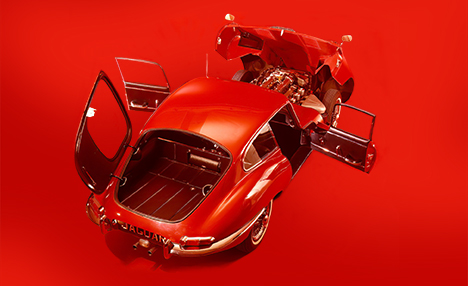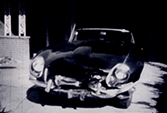Your Editor asked me to pen some words on the practicalities of classic car motoring in Britain, so that these might be compared with how things are done in the USA. Although the cars themselves may be the same, save for the position of the steering wheel, the rules and customs that govern their use differ considerably between Britain and the various states of the USA.
To take any vehicle onto the public roads of Britain, one first has to have what is commonly called a tax disc. This is the four-inch diameter colored disc that can be seen in the windscreen of British cars, each disc carrying the car’s registration (license plate) number, and also the month of expiry, for this disc has to be renewed every year! This paper medallion is not called a tax disc for nothing, as it currently costs £150 ($250) a year, a direct contribution to the tax revenues of the country. Once upon a time, it was known as the “road fund license,” for the revenues raised by its purchase were indeed spent on maintaining the roads. Fair enough, but for many years past, rapacious governments have grabbed the tax’s funds for other projects, to the extent that I believe only 20% of revenue now goes directly into road spending!
All is not gloom for owners of some classic cars, however, for some three years ago, after much lobbying, cars over 25 years old were made exempt from having to pay this tax, presumably on the grounds that they represented less than 1% of the vehicles in use, and covered relatively few miles anyway. Such classics still have to carry the tax disc, but it is issued with no duty being payable.
At first, this 25-year age exemption was a rolling date, and cars qualified for it as and when they entered their 26th year. However, last year, following our change of government, the bunch of school boys who claim to rule us made it a fixed date of January 1973, so that all cars manufactured prior to then still qualified for free road tax, but those made after do not. As things stand at present, they never will. It does not take an Einstein to see the inherent anomalies in this. If your TR6 or MGB was made on December 31, 1972, it travels for free. If made a day later on January 1, 1973: “That will be £250 a year, please!” Not surprisingly, the (illegal) trade in pre-1973 titles has perked up considerably, so I’m told…
However, you can’t just go buy a tax disc for your car. You first have to prove it is currently insured. Classic car insurance has boomed in Britain in recent years, and with much greater competition, premiums have fallen considerably, sometimes to almost ludicrously low levels…so much so that one wonders what funds would be in the pot after administration costs, to actually pay claims.
For instance, I insured my 1932 Riley Nine saloon last year, on an all-risks comprehensive basis, with an agreed value of £5000 ($8000), for a premium of just £60 ($100)! Admittedly, my mileage was limited to 3,000 in the year, but with weekend use and in such a relatively slow car, that limit was never going to be a problem! On most classic policies, one can choose a mileage limitation, and obviously the lower the agreed annual mileage, the lower the premium. One might wonder how the insurance companies police the mileages? Well, they generally take it on trust, simply asking for the owner’s honest declaration. However, some smarter insurers ask to see the vehicle’s MOT certificate which records the mileage at the day it was issued, and this brings me neatly to the next item without which one cannot obtain the essential tax disc.
As well as proving insurance, one also has to prove that the vehicle is fit for the road. I know that in the USA some states have quite severe annual roadworthiness tests, but other states, I understand, have virtually no checks, other than perhaps on emission levels and pollution, and these don’t always apply to classic cars. In Britain, we don’t have it so easy. If you have ever perused the British classic car adverts, you may have seen the phrase “long MOT.” The annual roadworthiness certificate is still known, even officially, as the MOT Test Certificate. MOT stands for the old Ministry of Transport, long since defunct. (I can’t recall what they call that government department this week, by the way!)
This annual certificate has to be produced, along with evidence of insurance, when applying for a tax disc, and all cars, going right back to the motorized dogcarts of the veteran era, have to be certified. There are certain age concessions to do with braking efficiency and lighting, but in general, it is quite a stiff test, and classic cars of the 1960s and ’70s have to comply with much the same standard of roadworthiness as the newer vehicles, except in regards to exhaust emissions. The fee for the half-hour test, which covers brakes, lights, steering, suspension, corrosion, and much more besides, is around £30 ($50).
Who undertakes the testing? In many European countries, an impartial government testing station is used, but in Britain, it is the ordinary motor dealers and repairers who are licensed to carry out the MOT test. Now, should you think that this might on occasion lead them to be less than fair in their search for “faults,” so that they can then charge you to “repair” them, then you’d be right.
Unfortunately, corruption is an inbuilt element of the system. The general advice over here is that when you find a fair and reasonable MOT man—stick with him! Another problem these days is that your average MOT tester is younger than some of the classics he tests, and simply doesn’t understand old fashioned motor engineering. They don’t know that cam and peg steering never was, and never can be, as precise as rack and pinion units. So they fail TR3s for having two inches of play at the steering wheel, which for those who know their early TRs is inherent. As for “fly-off” hand brakes, I’ve lost count of the number of times I’ve had to explain to young testers, “No, it’s not broken, it’s meant to work like that!”
So, armed with your hard-won MOT certificate, an insurance certificate, the title documents (commonly called a log book in Britain), plus £150 in cash if your car was made in 1973 or later, you can at last obtain your tax disc, and hit the road—if, of course, you can afford the gas! In my conversations with USA owners of classic cars who have never been to Europe, I’ve found that many simply don’t believe me when I tell them the price of fuel over here! “How can you guys afford to go anywhere?” they say, and indeed, we often ask that ourselves. No wonder so many Europeans now drive 60-mpg turbo diesels as everyday vehicles!
Al the lime of writing (December 1998), unleaded gas costs a minimum of £3 per gallon. (That’s nearly five dollars a gallon, even allowing for the fact that our British gallon is somewhat bigger than the US one.) Last summer, I bought unleaded regular gas in Arizona for 99 cents a gallon, just about one fifth of the price we pay, and we have our own North Sea oil! Where does the money go? To those vultures in the government, of course, who take around 85% of the pump price in taxes! Would you believe they’re threatening to raise the price to discourage us from using our cars so much? At least we can buy 98 octane leaded fuel for another year, but this disappears in the year 2000. Mind you, this costs some $6 a gallon! Be thankful for what you have, my American friends!
In a future issue, I hope to deal with driving habits and regulations, and how they differ between the UK and the USA, and also provide a few words on the British license plate system.







'Oh the Joys: Spring 1999' has no comments
Be the first to comment this post!